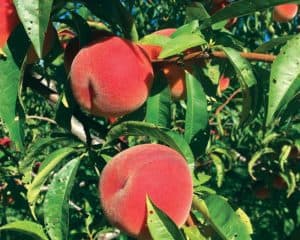By Bonnie Kirn Donahue, UVM Extension Master Gardener
Peaches are one of the more surprising fruits that grow in Vermont. Easy to pick and fantastically juicy, peaches are beautiful, fuzzy globes to look forward to each summer.
Growing peaches is often associated with warmer climates, such as Georgia or South Carolina, as well as Pennsylvania, New Jersey and other mid-Atlantic states. Vermont’s U.S. Department of Agriculture’s cold hardiness zones are on the cold-end of the peach-growing spectrum, ranging from 3a to 5b across the state. Luckily, certain varieties of peaches have been adapted to grow in cooler climates, and in some cases, can be grown here.

Two varieties that do well in cooler climates are “Reliance” and “Contender.” “Reliance” was developed in New Hampshire and is known for its reliable cold hardiness. “Contender” is known for its high quality fruit, though is potentially not as cold-hardy as “Reliance.”
Because Vermont is fairly cold for peach growing, site selection is very important. It may be easier to grow peaches in parts of the state that have milder winters and warmer weather although the right microclimate in cooler areas can have a positive impact. Choose a warm site with plenty of sun and protection from wind. Peaches like soil that is well-drained. Be sure to pick a site that has enough space for each tree to grow. A peach tree will grow approximately 15-20 feet wide and tall and will need at least that amount of space per tree.
Unlike apples, peaches are self-fruitful or self-pollinating, meaning that they do not require a second tree to pollinate and produce fruit. This means that you can start with just one tree if desired.
Peach trees can be found at local fruit nurseries across the state. If you can, talk to the local nursery owners about their experience growing peaches. They will have invaluable information to offer.
You will likely find peach trees for purchase in containers or as bare roots. Containerized trees are available in a variety of sizes and prices. Bare roots are small, dormant woody plants without soil that must be planted within 24-48 hours of purchase. The advantage to these plants is that they are less expensive; the disadvantages are that the plants are smaller, so it takes longer to produce a peach.
Planting a peach tree is much like planting a deciduous tree. Check out the Vermont Urban and Community Forestry resources on planting trees (go.uvm.edu/treeplanting) to make sure you start your tree off on the right foot.
After your peach tree is planted, it will need to be watered at least 1-2 inches per week for the first year (including rainfall). This watering will help the roots get established in its new site. Depending on the size of your tree, after about 2-5 years, you can expect to have peaches to pick. Peaches are ready to pick when they turn a yellow-orange to pink and release fairly easily from the branch. Peaches can be kept on the countertop until completely ripe (there should be a little bit of give when gently squeezed). Ripened peaches can be stored on the counter or in the refrigerator in bags or containers for a week.
Interested in having peaches sooner? Look for pick-your-own farms that offer peaches in addition to other fruits like apples, pears and sour cherries.




